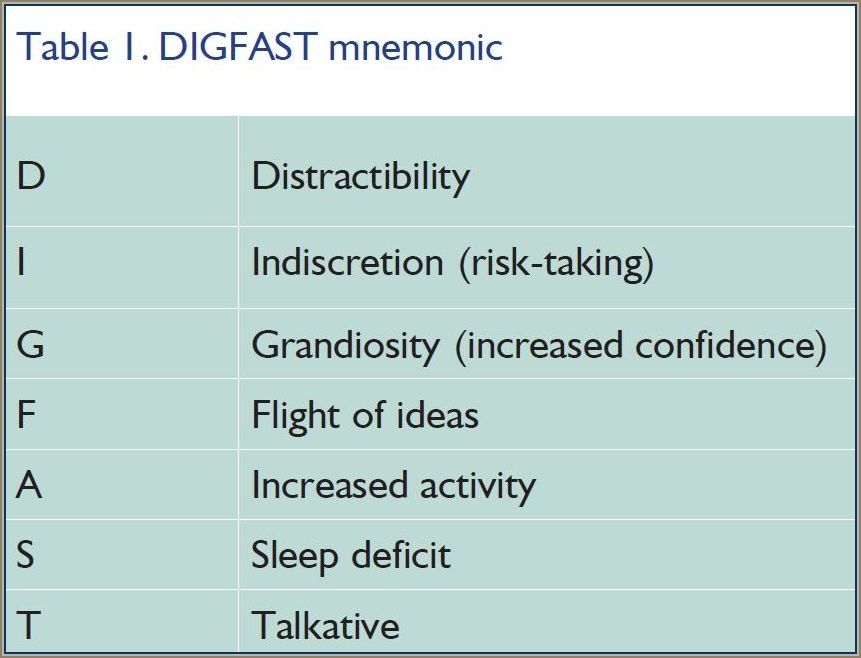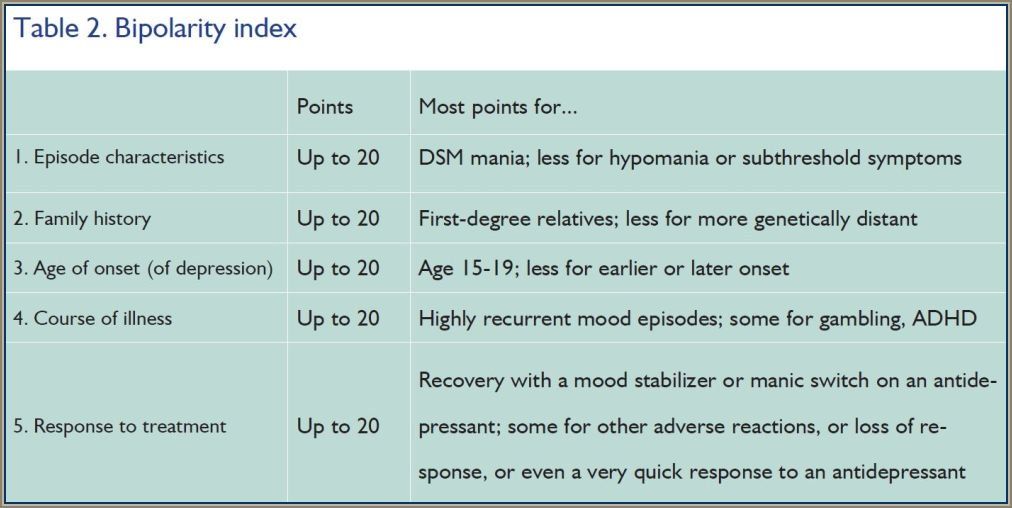Article
CrowdStudying Ourselves: Approaches to Bipolar Disorders, Part 2
Author(s):
A window into what your colleagues actually think and do.
Table 1. DIGFAST mnemonic

Table 2. Bipolarity index

In Part 2 of this series, I again ask for your feedback to help provide a window into what practicing psychiatrists actually think and do. When we have a large N, I’ll add a synthesis of the series.
The questions in Part 1 focused on the prevalence of bipolar disorder among patients who present with depression in your practice. Here, I ask about your approach to these patients.
When you assess a patient with depression, which most closely describes your approach? Please answer in the comments box. Please indicate if you are a non-clinician.
For the discussion, see the next page>>
Answer: Option A is justifiable per the structure of the DSM: if criterion A (elated, expansive, or irritable mood, with increased energy) is not met, the diagnosis cannot be supported. Given the DSM’s widespread use and acceptance, and the fact that it remains the official diagnostic system of the American Psychiatric Association, one could argue that A is the “correct” answer.
You might have picked option B because you assess the B criteria even when A criteria are weak (eg, of less than 4 days’ duration). Many practitioners use the DIGFAST mnemonic to remember the B criteria (Table 1).
Option C: the spectrum view
Controversy continues regarding the validity of the DSM cutoffs. Whereas the new “increased energy” criterion in the DSM-5 was supported in a study of diagnostic validity, the duration criteria (at least 4 days for hypomania and 7 days for mania) were not: hypomania as brief as 1 day was also found valid.1
Likewise, if you’ve been in practice for long, you’ve seen all sorts of variations of the B criteria, from obvious to subtle to uncertain to dubious-but-not-clearly-absent. Such observations make sense with the finding of at least 226 genes associated with bipolar disorder at the P < 0.05 level.2 Imagine all the variations possible with even just 10 main pathways, if each has tens of allelic differences.
Thus, prominent mood specialists-including the chairman of the DSM-5,3the head of the former Bipolar Spectrum Division (now the Section on Mood Dysregulation) at the National Institute of Mental Health (NIMH),4 and the head of the largest bipolar research program to date, the STEP-BD5-have endorsed viewing mood disorders as a spectrum from purely unipolar to fully bipolar. Unlike pregnancy, one can be “a little bipolar.”
Option D
You always take a family history in a new patient, right? Why? Because you know that depression in a patient whose first-degree relative has a reliable diagnosis of bipolar disorder (eg, “Oh Dad, when he didn’t take his lithium, he’d end up in the hospital, but on it, he did well for years”) is more likely to be bipolar depression than if the family history were negative. A positive family history does not make the diagnosis of bipolar disorder, but it strongly influences the probability thereof.
If it makes sense to take a family history, then it makes sense to check all the other variables that have also been statistically associated with bipolar outcomes. Presented in 2002 as additional diagnostic criteria by the former head of the NIMH, Fred Goodwin, and his colleague Nassir Ghaemi,6 these variables were organized in a simple system for the STEP-BD research program: the Bipolarity Index.
For the Bipolarity Index, see next page >>
The Bipolarity Index
The Index includes the DSM criteria but adds 4 other components (a quick way to assess all this is presented in Table 2).
Notice: the STEP-BD researchers gave 80% of the weight (items 2-5) to the non-manic bipolar markers.7 That’s how important they think these variables are in the process of bipolar diagnosis. The Index has since been validated three times.8-10 But you don’t have to ask about all these additional variables in your time-crunched initial interview. There’s an easier way.
Questionnaire approach
Between the A and B criteria of the DSM, there are 11 variables. In the Bipolarity Index, there are an additional 10 to 11 variables, depending on how you count. That’s over 20 individual questions-too many for an initial interview in which you are not just gathering data but laying the groundwork for shared decision-making and treatment, already an overloaded agenda.
At Samaritan Mental Health, we use a questionnaire to gather data on these 22 variables. After 5 years of regular use, I can’t imagine life without it. Since bipolar disorder is in the differential for nearly every psychiatric presentation (from anxiety to ADHD, organic to characterologic), we use it with every new inpatient and outpatient.
The next essay in this series will focus on that questionnaire, called MoodCheck. Come back next month for more on this shortcut to the Bipolarity Index.
Disclosures:
Dr. Phelps is Director of the Mood Disorders Program at Samaritan Mental Health in Corvallis, Ore. He is the Bipolar Disorder Section Editor for Psychiatric Times. Dr. Phelps stopped accepting honoraria from pharmaceutical companies in 2008 but receives honoraria from McGraw-Hill and W.W. Norton & Co. for his books on bipolar disorders, including Bipolar, Not So Much, a book he coauthored with Chris Aiken, MD.
References:
1. Angst J, Gamma A, Bowden CL, et al. Diagnostic criteria for bipolarity based on an international sample of 5,635 patients with DSM-IV major depressive episodes. Eur Arch Psychiatry Clin Neurosci. 2012;262:3-11.
2. Nurnberger JI Jr, Koller DL, Jung J, et al; Psychiatric Genomics Consortium Bipolar Group. Identification of pathways for bipolar disorder: a meta-analysis. JAMA Psychiatry. 2014;71:657-664.
3. Phillips ML, Kupfer DJ. Bipolar disorder diagnosis: challenges and future directions. Lancet. 2013;381:1663-1671.
4. Leibenluft E. Categories and dimensions, brain and behavior: the yins and yangs of psychopathology. JAMA Psychiatry. 2014;71:15-17.
5. Saenger E. The Bipolarity Index as a tool for assessment and creating rapport: an expert interview with Gary Sachs, MD. Medscape Psychiatry. 2005;10(1).
6. Ghaemi SN, Ko JY, Goodwin FK. “Cade’s disease” and beyond: misdiagnosis, antidepressant use, and a proposed definition for bipolar spectrum disorder. Can J Psychiatry. 2002;47:125-134.
7. The Bipolarity Index. http://psycheducation.org/diagnosis/bipolar-diagnosis-spectrum-or-yesno/the-bipolarity-index/. Accessed July 14, 2017.
8. Aiken CB, Weisler RH, Sachs GS. The Bipolarity Index: a clinician-rated measure of diagnostic confidence. J Affect Disord. 2015;177:59-64.
9. Ma Y, Gao H, Yu X, et al. Bipolar diagnosis in China: evaluating diagnostic confidence using the Bipolarity Index. J Affect Disord. 2016;202:247-253.
10. Mosolov S, Ushkalova A, Kostukova E, et al. Bipolar II disorder in patients with a current diagnosis of recurrent depression. Bipolar Disord. 2014;16:389-399.






